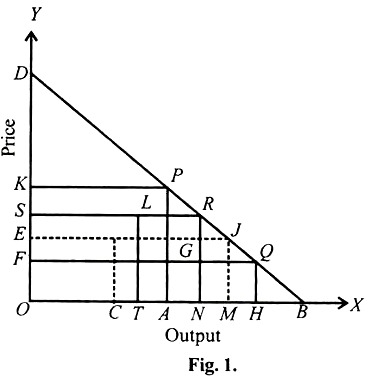The following points highlight the two main economic ideas of Cournot. The economic ideas are: 1. Demand Curve 2. Cournot’s Model of Duopoly.
1. Demand Curve:
Cournot introduced demand curve in economics. He defined market, which is often quoted by modern economists, as “Economists understand by the term market, not any particular market place in which things are brought and sold, but the whole of any region in which buyers and sellers are in such free intercourse with one another that the prices of the same goods tend to equality easily and quickly”.
He showed that under unlimited competition price equated the marginal cost of production. In the last chapter of his book he wrote that under special circumstances protective duties increased the national income. He differed from the classical theory of value as he held that the three elements—demand, supply and price were interdependent. Chapters on social income in his book have been considered unsatisfactory.
2. Cournot’s Model of Duopoly:
Cournot takes the case of two identical mineral springs operated by two owners who are selling the mineral water in the same market. The waters are identical.
ADVERTISEMENTS:
Assumptions:
(1) His model relates to the duopoly with homogeneous products.
(2) The owners operate mineral springs and sell water without any cost of production.
(3) Cost of production is taken as Zero.
ADVERTISEMENTS:
(4) Only the demand side of the market is analysed.
(5) The market demand for the product is assumed to be linear (straight line demand curve)
Cournot begins his analysis with the fundamental assumption that the duopolist will decide about the amount of output which is most profitable for him to produce in the light of his rival’s present output and assume it not to change. Suppose the demand curve confronting the two producers of the mineral water is the straight line H DB as shown in the following figure (Fig. 1.).
Further suppose that OA = AB is the maximum daily output of each spring, total output is OA + AB = OB, which is offered for sale in market, the price will be zero. Assume that one producer of the mineral water is monopolist — he starts the business first. He will then produce daily OA output which is his maximum daily output, for his profits will be maximum at output OA, and will be equal to OAPK.
ADVERTISEMENTS:
The price which that producer will charge will be AP. Suppose now that the owner of the other spring enters into the business and starts operating his spring. He sees that the former producer is producing OA amount of output. According to Cournot’s basic assumption, the new producer believes that the former producer will continue to produce OA (=1/2 OB) amount of output and PB as the demand curve confronting him (new producer).
With his demand curve PB, the producer will produce AH (=1/2 AB) amount of output. The total output will now be OA + AH = OH, and the price will fall to HQ per unit. The total profits made by the two producers will be OHQF which are lese than OAPK.
Out of total profits OHQF, profits of producer I will be OAGF and profits of producer II will be AHQG. Now that the profits of producer I are reduced from OAPK to OAGF by producer II producing output AH, the producer I will reconsider the situation. But he will assume that producer II will continue to produce output AH.
With producer II producing output AH, the best that producer I can do is to produce 1 /2 (OB-AH) = OT. He, therefore, reduces his output from OA to OT. With output OT of producer I and output AH of producer II, the total output will be OT +AH = ON and the price of the product will be NR and the total profits of the two producers will be ONRS. Out of the total profits ONRS, the profits to producer I will be OTLS which are greater than his previous profits OAGF and profits to producer II will be TNRL which are greater than his previous profits AHQG.
This process of adjustment and readjustment by each producer will continue, until the total output OM is produced,(OM = 2/3 OB) and each is producing the same amount of output. In this final position, producer I produces OC amount of output and producer II produces CM amount of output, and OC = CM.
Throughout the process of adjustment and readjustment, each producer assumes that the other will keep his output constant at the present level. So finally the total profits OMJE are made by them in Cournot’s duopoly equilibrium.
It is thus clear that the prices and the profits are lower and output is greater than if they had combined together and formed a monopoly. To conclude in the words of Fisher, “he exerts a powerful influence on economic thought. It is with him therefore that any survey of modern mathematical economics should begin”.
